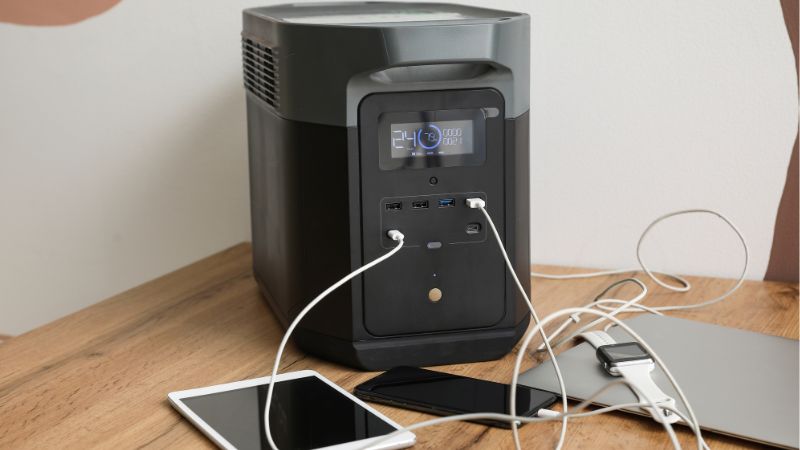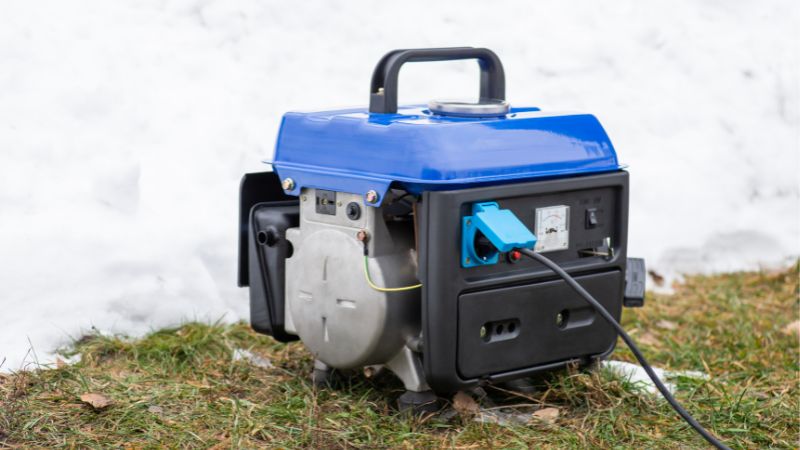When the power goes out, having a backup power source becomes essential. But should you choose a generator or a portable power station? Understanding the difference can help you make the right choice for your needs.

What are Generators?
Generators are devices that create electricity using mechanical energy. They typically run on fuels like petrol, propane, or diesel to power an engine that produces electricity.
One important thing to know is that generators create electricity rather than storing it. This means they can run for as long as you have fuel available.
Generators are perfect for high-power needs. You might use a generator when camping, during power outages, or at construction sites.
These machines can keep your essential appliances running when the grid goes down. You can use them to run power tools, air conditioners, or even a small home during emergencies.
What are Portable Power Stations?
Portable power stations are portable devices that store electricity in batteries for later use. Unlike generators, they don’t create power—they simply hold it until you need it.
Most portable power stations store energy in a battery, which you can charge by plugging into a wall outlet. Many models can also be charged using solar panels, making them great for camping or emergency situations.
They’re completely silent and produce zero emissions when in use. This makes them perfect for indoor use or situations where noise and fumes would be a problem.
Most portable power stations include multiple output options like AC outlets, USB ports, and DC ports. This versatility lets you power or charge various devices at once.
The main limitation? portable power stations eventually run out of juice. Once the battery is drained, you’ll need to recharge it before using it again. This is different from generators which can run continuously as long as they have fuel.
Difference between Generators and Portable Power Stations
When choosing a power solution, understanding the key differences between a generator and a portable power station is essential.

Power Performance
Generators typically offer higher power output. Generators can run as long as they have fuel. A standard portable generator can produce 2,000-10,000 watts continuously, making them suitable for powering multiple appliances simultaneously.
Portable power stations generally have lower output capacity, usually between 200-2,000 watts. This makes them ideal for smaller devices, such as smartphones and laptops, but less suitable for high-power applications.
Usage Scenarios
You’ll find generators most useful during extended power outages where high power needs exist. They’re perfect for construction sites, outdoor events, and emergency backup for homes during storms.
Generators are also crucial for powering medical facilities during emergencies, ensuring critical equipment stays operational.
Portable power stations excel in situations where clean, quiet power is needed like camping trips, small outdoor gatherings, or powering essential devices during short outages. They’re also ideal for charging electronics, running CPAP machines, or powering small appliances.
For indoor use, power stations are the only safe option since they produce no emissions. Generators must always be operated outdoors due to carbon monoxide risks.
Cost
Initial purchase price differs significantly between these options.
Generators typically range from $300-$1,500 for consumer models. Generators require ongoing fuel purchases (gasoline, propane, or diesel), regular maintenance, and occasional repairs to the engine.
While comparable portable power stations cost more upfront—usually $500-$3,000 depending on capacity. Power stations have minimal operating costs beyond the initial electricity needed to charge them. Many can be recharged using solar panels, potentially reducing costs further.
Scale of Operation and Output
Generators come in various sizes, from small portable units to large standby systems capable of powering entire homes. Residential models typically provide 5,000-20,000 watts, while commercial generators can produce much more.
Portable power stations are more limited in scale, with most consumer models offering 500-3,000 watt-hours of capacity. This scaling difference is important when planning for your power needs.
Consider these typical appliance requirements when choosing:
- Refrigerator: 100-200 watts
- Laptop: 45-90 watts
- LED lights: 10-15 watts per bulb
- Window AC: 500-1,500 watts
Portable power stations work well for charging devices and running small appliances, while generators can handle energy-intensive equipment like power tools and larger appliances.
Installation and Maintenance
Generators require more complex setup and maintenance. You’ll need adequate ventilation space, fuel storage, and regular maintenance including oil changes, filter replacements, and spark plug checks. The lifespan of generators is typically 5-10 years if properly maintained.
Portable power stations are essentially plug-and-play devices. They require no installation—simply charge them beforehand and they’re ready to use. Maintenance is minimal, typically limited to keeping the unit clean and properly storing it. However, power stations have a shorter lifespan due to battery degradation affecting their endurance.
Environmental Impact
The environmental difference between these options is significant.
Traditional generators produce carbon monoxide, carbon dioxide, nitrogen oxides, and particulate matter during operation.
Noise pollution is another environmental factor. Generators create constant noise that can disturb wildlife and neighbors, while power stations operate silently. Traditional portable generators can produce noise levels reaching up to 100 decibels, which is comparable to city traffic or power tools.
Portable power stations create zero emissions during use. When charged via solar panels, they offer a completely clean energy solution with minimal environmental impact.
However, there are now quiet generators on the market that significantly reduce noise pollution compared to traditional models. This generator is designed to be much quieter while still providing high power output, making it a more environmentally friendly option.
Advancements in Generators and Portable Power Stations Technology

Generator and power station technology has evolved significantly in recent years, focusing on efficiency, sustainability, and user convenience. These improvements have made both options more attractive for different power needs and situations.
Innovations in Generator Design
Modern generators have become much more user-friendly than their predecessors. Many now feature electric start systems instead of pull cords, making them easier to operate—especially in harsh weather.
Noise reduction technology has improved dramatically. Newer inverter generators operate at around 50-60 decibels, which is quieter than normal conversation. This makes them more neighborhood-friendly and suitable for camping.
Fuel efficiency has also seen major improvements. Today’s generators can run longer on less fuel, with some models automatically adjusting engine speed based on power demand.
Smart features now allow you to:
- Monitor fuel levels remotely
- Check power output via smartphone apps
- Receive maintenance alerts
- Schedule automatic testing
Dual-fuel and tri-fuel generators give you flexibility to use gasoline, propane, or natural gas depending on availability during emergencies.
Sustainable Developments in Power Station Construction
Portable power stations have embraced lithium-ion battery technology, dramatically reducing weight while increasing capacity. The latest models can store over 2,000Wh of power yet remain lightweight enough for one person to carry.
Solar integration has become seamless with most power stations. You can now charge your power station using solar panels, making them truly off-grid solutions during extended outages or camping trips.
Battery management systems have improved significantly, extending the lifespan of your investment. Many units now last through 2,000+ charging cycles before noticeable capacity degradation.
Power stations now feature multiple output options including:
- USB-C with Power Delivery
- 12V car ports
- Standard AC outlets
- Wireless charging pads
Pass-through charging capabilities let you use your power station while it’s being recharged, ensuring you’re never without power when you need it most.
Conclusion
When choosing between a generator and a power station, your specific needs matter most. If you need to power your entire home during long outages, a generator is the best choice. For short power outages or camping trips, a portable power station might be your best friend.
Frequently Asked Questions
What are the common disadvantages associated with the use of portable power stations?
Limited capacity is the biggest drawback. Most portable power stations can only power essential devices for a relatively short time compared to fuel generators.
Recharging can be slow, especially with solar panels in less-than-ideal conditions. Wall outlet charging might take 6-12 hours for a full recharge.
How does the operational mechanism of an inverter generator differ from that of a portable power station?
Inverter generators burn fuel to produce AC power, then convert it to DC and back to AC for clean, stable electricity.
Power stations simply store electricity in batteries and deliver it through an inverter when needed. They don’t generate power but distribute what they’ve stored.
Can generators and portable power stations be used indoors?
Generators are not safe for indoor use because they produce carbon monoxide, a harmful gas. Always use them outside with good ventilation. Portable power stations, on the other hand, are totally fine indoors. They don’t make any noise or pollution.
